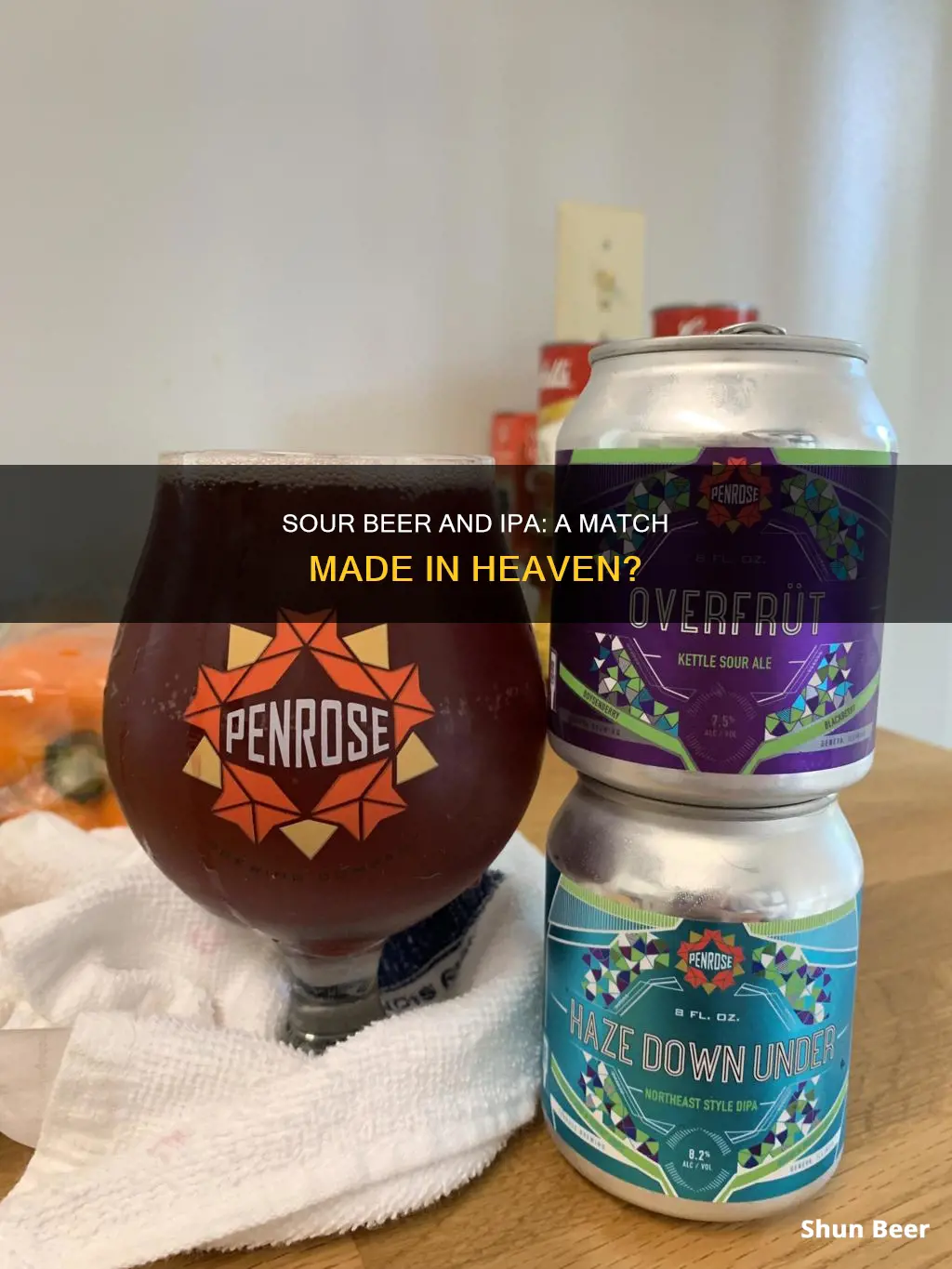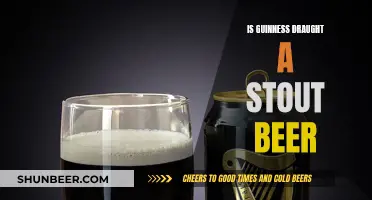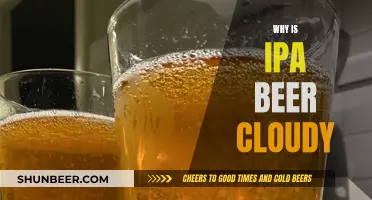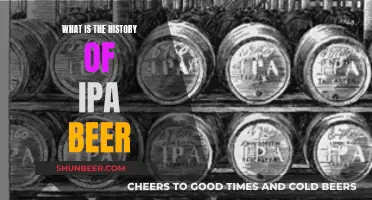
Sour IPAs are a combination of an IPA and a sour beer. They are made using the softest malts, the trendiest hops, and the most luscious fruit purees. The taste of a sour IPA is based on New England IPAs (NEIPAs), and they usually have a fruity, tangy, or tarty flavor. However, the best example would be clean acidity paired with all the qualities of a NEIPA.
Sour IPAs are set apart by their souring agents—lactobacillus cultures that impart a tart characteristic. Compared to other cultures, lactobacillus plantarum is considered the best fit for brewing sour IPAs because of how quickly it creates acidity. The process of creating a sour IPA is called kettle souring, which involves souring unfermented wort in a short period of time, typically between 24 hours to several days.
While some people enjoy the unique blend of a sour IPA, others find that bitter and sour flavors do not mix well together. It is important to note that the taste of sour IPAs can vary depending on the hops used, and they should not taste bitter. The goal of making a sour IPA is to soften the bitter taste of an IPA so that it harmonizes with the sourness or tartness.
| Characteristics | Values |
|---|---|
| Taste | Fruity, tarty, tangy, acidic |
| Base | New England IPA (NEIPA) |
| Souring agents | Lactobacillus, Pediococcus, Brettanomyces |
| ABV | 5% to as high as 9% |
| Calories | 160 to 270 for a 12 oz can with 5% ABV |
| Calories | 260 to 270 for a 12 oz can with 9% ABV |
What You'll Learn

Sour IPAs are a blend of an IPA and a sour beer
The key to making a Sour IPA is to use a process called kettle souring. This technique involves souring unfermented wort rapidly, usually within 24 hours to several days. The wort is boiled and then cooled to a specific temperature range before adding lactobacillus, a type of bacteria that turns sugar into lactic acid, giving the beer its characteristic sourness.
In addition to kettle souring, brewers may also use wild yeast and other bacteria such as Pediococcus and Brettanomyces to enhance the flavour profile. The wild yeast adds earthy tones, while Pediococcus increases acidity. Brettanomyces, or Brett for short, adds flavours and aromas that may not be appealing on their own but can contribute to a well-balanced beer when used in moderation.
The hops used in Sour IPAs are typically fruity and juicy varieties, with late additions or dry hopping techniques to soften the bitterness. Oats, rye, and wheat malts are commonly used to create a soft and supple mouthfeel.
Sour IPAs offer a unique sensory experience that blends the best of both IPAs and sour beers. The style is still evolving, and while it may not be as popular as Hazy IPAs, it has gained a cult following among craft beer enthusiasts.
The Oldest Beer: Guinness's Historical Journey
You may want to see also

Sour IPAs are inspired by New England IPAs (NEIPAs)
Sour IPAs were inspired by New England IPAs (NEIPAs). NEIPAs are known for their fruity, hoppy flavour with low bitterness and a smooth mouthfeel. They are ridiculously juicy, almost like biting into ripe fruit. Sour IPAs take this a step further by adding a tangy, bright, juicy, and acidic kick to the mix.
The idea behind Sour IPAs is to combine the best qualities of a NEIPA with clean acidity. While it may seem odd to mix bitter and sour flavours, Sour IPAs do just that. The key is to soften the bitter taste of the IPA so that it harmonises with the sourness or tartness, rather than clashing with it. This is achieved by using specific ingredients and brewing techniques.
The star ingredients of Sour IPAs are wild yeast and two types of bacteria: Brettanomyces (Brett for short), Lactobacillus, and Pediococcus. Brettanomyces adds a layer of earthy tones, while Lactobacillus and Pediococcus are responsible for the tartness and acidity. Lactobacillus is a bacteria commonly found in yogurt, and it turns sugar into lactic acid, giving the beer its characteristic sour flavour.
The brewing process for Sour IPAs also differs from regular IPAs. One crucial technique is kettle souring, which allows brewers to rapidly sour unfermented wort within a short period, usually 24 hours to a few days. This technique, along with the use of specific souring agents, gives Sour IPAs their unique style.
In terms of hops, it is advisable to stick to fruity and juicy varieties. Additionally, brewers may choose to omit the step of adding hops during the kettle boil to soften the bitterness. For the malts, oats, rye, and wheat are good choices as they contribute to a soft and supple mouthfeel.
Sour IPAs offer a unique sensory experience that blends the fruitiness of NEIPAs with the tanginess of sour beer. While it may be a niche brew, it has gained a cult following, with some breweries dedicated to perfecting this style.
The Irish Heritage of Guinness Beer
You may want to see also

Sour IPAs are made using the kettle souring method
Kettle souring is a quick and efficient way to produce sour beers, as it can be completed within 24 to 48 hours. The process involves creating a wort with no hops, boiling it for sanitation, and then chilling it to a temperature between 75-90°F (24-35°C). Once chilled, a culture of pure Lactobacillus is introduced, and the kettle is tightly sealed. The Lactobacillus rapidly sours the wort within 1 to 3 days. After souring, the wort is boiled again to kill the Lactobacillus, and then hops are added as per the standard brewing process.
Kettle souring is an alternative to the traditional method of barrel aging, which can take months or even years to complete. By adding microbes that produce lactic acid before fermentation, brewers can significantly shorten the aging period needed to make a sour beer. Lactobacillus thrives in warm and consistent temperatures, so kettle souring is generally done in brew kettles.
The key advantage of kettle souring is the reduced risk of contamination since the souring bacteria are killed during the boil. Additionally, the process of producing a sour beer is similar to brewing a standard batch of ale, making it accessible to both professional and home brewers. However, one drawback of kettle souring is that the beers may not have the same complex flavor profile as those aged in barrels for extended periods.
IPA Beers: Why Are They So Popular?
You may want to see also

Sour IPAs are made with wild yeast and two types of bacteria
Sour IPAs are a unique style of beer that combines the characteristics of an IPA with the tartness of a sour beer. While the combination of bitter and sour flavours may seem unappealing, Sour IPAs have gained a dedicated following and are becoming a cult favourite.
The star ingredients of Sour IPAs are wild yeast and two types of bacteria. The wild yeast used is Brettanomyces, also known as "brett". Brett is unusual in that it can ruin beer by adding undesirable flavours and aromas. However, when used in the right proportions, it adds a layer of earthiness that balances out the fruity and tart flavours of the beer.
The two types of bacteria used in Sour IPAs are Lactobacillus and Pediococcus. Lactobacillus is the same bacteria found in yogurt and is responsible for its tangy flavour. In Sour IPAs, Lactobacillus converts sugar into lactic acid, giving the beer its characteristic sourness. Pediococcus, on the other hand, is used primarily to add acidity. It works more slowly than Lactobacillus, allowing the primary yeast strain to complete its fermentation before significantly lowering the pH of the beer.
The process of making a Sour IPA differs from that of a regular IPA. One key technique used is kettle souring, which involves souring unfermented wort rapidly, usually within 24 to 48 hours. This process, along with the use of souring agents, wild yeast, and Lactobacillus, gives Sour IPAs their distinctive flavour and style.
Sour IPAs offer a unique sensory experience, blending the hoppy, fruity notes of an IPA with the tangy, acidic flavours of a sour beer. While this combination may not be for everyone, it has certainly carved out a niche in the craft beer world, attracting those who enjoy exploring new and experimental styles.
The High Price of Guinness Beer: Is It Worth It?
You may want to see also

Sour IPAs are not very bitter
The goal of making a Sour IPA is not to remove bitterness entirely. Instead, brewers aim to reduce the perception of bitterness so that it doesn't clash with the sourness of the beer. This is achieved through various methods, such as softening the bitter taste, using specific types of hops, and controlling the brewing process.
One technique used to soften the bitterness in Sour IPAs is dry hopping. Dry hopping involves adding hops to the beer after fermentation or days to weeks after brewing. By adding hops at a later stage and at room temperature, the compounds in the hops that cause bitterness are reduced, resulting in a more subtle bitterness. This technique is commonly used in Sour IPAs to create a balanced flavour profile.
Additionally, brewers may choose to use fruity and juicy hop varieties that contribute to the desired flavour profile without adding excessive bitterness. These hops are often added during the whirlpool process rather than the kettle boil to further soften the bitterness. Oats, rye, and wheat are also commonly used as malts in Sour IPAs, as they provide a soft and supple mouthfeel that complements the reduced bitterness.
The brewing process itself also plays a crucial role in controlling the bitterness of Sour IPAs. By souring the beer rapidly through kettle souring, brewers can create a tart base for the beer. This process involves adding Lactobacillus to the wort and allowing it to turn the sugar into lactic acid, resulting in a sour flavour. The use of Lactobacillus and other souring agents gives Sour IPAs their unique style.
While the bitterness in Sour IPAs is intentionally softened, it is important to note that the level of bitterness can vary depending on the recipe and brewing techniques employed. Some Sour IPAs may have a more restrained bitterness, while others may have a slightly more pronounced bitterness. Ultimately, the goal is to strike a balance between the bitter and sour elements to create a harmonious flavour profile.
Guinness Beer: Wheat-Free, But What's the Secret?
You may want to see also
Frequently asked questions
Sour IPAs are a combination of an IPA and a sour beer. They are made with the softest malts, the trendiest hops, and the most luscious fruit purees. They have a similar hop profile, body, and mouthfeel to a NEIPA but with added tartness.
Sour IPAs are made using a process called kettle souring. This technique allows brewers to sour unfermented wort rapidly in a short period of time, usually between 24 hours to several days. Lactobacillus cultures are added to the wort to impart tartness. Hops are then added to the beer days or weeks after brewing, which softens the bitterness.
Sour IPAs have a fruity, tart, or tangy flavor with clean acidity and all the qualities of a NEIPA. They should not taste bitter as bitter and sour do not mix well together.
Yes, there are several Sour IPAs available to try, including:
- Wiley Roots Brewery Key Lime County Fair Cobbler
- Sixpoint Brewery Party Pinata
- Commonwealth Brewing Magic Scones
- Hudson Valley Brewery Bloom
- New Belgium Brewing Sour IPA







